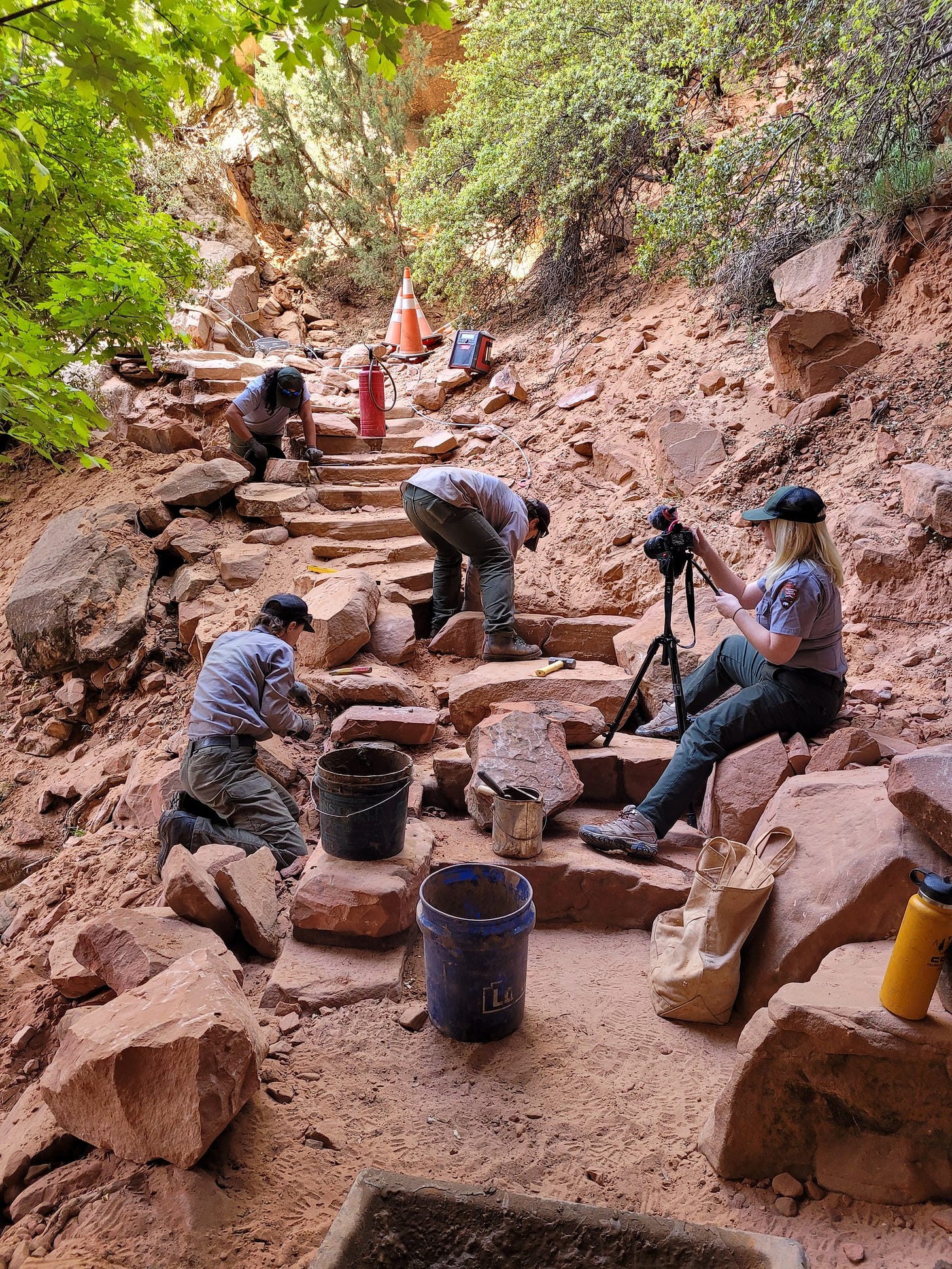Over 1,000 Park Service Employees Are Currently at Risk of Termination—On Top of an Already Historic Staff Reduction
A Supreme Court order opens the door to mass layoffs in the National Park Service
America’s national parks—once the proud standard-bearers of natural beauty and cultural heritage, and often referred to as “America’s best idea”—are under siege, not just by wildfires or invasive species, but by political decisions threatening to dismantle their very foundation.
Under the Trump administration, an aggressive reduction in staffing, a sweeping consolidation of administrative functions, and a Supreme Court decision allowing further mass layoffs have plunged the National Park Service (NPS) into an unprecedented crisis.
The fallout is national and far-reaching. From Yosemite’s shuttered Pioneer History Center to lifeguard-less beaches at Assateague Island, the Park Service is buckling under pressure as it tries to meet record visitation levels with its lowest staffing levels in decades.
Supreme Court Greenlights Additional Layoffs
The Supreme Court recently ruled in favor of the Trump administration’s push for a sweeping “reduction in force,” essentially greenlighting thousands of additional layoffs across the NPS and other federal agencies.
This would be on top of the already severely reduced NPS workforce—since January 2025, the agency has lost 24% of its permanent employees as a result of terminations, resignations, and buy-out offers.
And that drop followed a 20% decline since 2010, creating a dangerous deficit of park rangers, scientists, educators, maintenance workers, search-and-rescue crews, and firefighters when they are needed most.
Yet while visitation soars—with a record 331.9 million visits in 2024 alone—the ability to maintain trails, provide safety, and protect irreplaceable cultural artifacts is collapsing.
Over 1,000 Additional Layoffs Are Coming to the Park Service
Let’s eliminate all confusion: these new staffing reductions are on their way. They’re entirely in line with the President’s Fiscal Year 2026 Budget Request—you can read that here. The National Park Service’s section starts on page 550.
In the 2026 budget, you can literally see the exact numbers of NPS staff they’re intending to eliminate.
This current fiscal year, the NPS has an estimated 14,548 full-time equivalent employees (FTE). But next fiscal year, there will be only 10,020 left—an unprecedented 31% reduction in staff in one single year.
Considering that the Park Service has already lost 24% of its fulltime staff since January, that leaves another 7% to be cut to reach their “goal” of 10,020 of FTE.
In absolute numbers—7% of 14,548—that would be 1,018 more National Park Service layoffs in the near future.

Analysis released on July 9 by a coalition of four park advocacy groups—the National Parks Conservation Association (NPCA), Association of National Park Rangers (ANPR), Coalition to Protect America’s National Parks (CPANP), and Public Employees for Environmental Responsibility (PEER)—shows the real-world effects of those recent (and planned) staffing cuts.
The NPCA warns that this decision could cripple the ability of national parks to function, let alone thrive.
Combined with the Trump administration’s proposed massive budget cuts, this could result in the forced closure of numerous national park sites.
“The National Park Service is reeling from historic staffing losses. Nearly a quarter of its permanent staff are gone, and the rest are being stretched to the brink just trying to keep parks open, safe and protected. The Supreme Court has opened the door to even deeper, more dangerous cuts, putting thousands of Park Service staff and the future of America’s national parks at risk. It took more than a century to build a world-class park system, and this administration could unravel it in a matter of months.” - Theresa Pierno, President and CEO of the National Parks Conservation Association
As reported by the NPCA in a recent article, the decision paves the way for the Department of the Interior (DOI) to execute layoffs with limited Congressional oversight, despite bipartisan efforts to protect essential public lands staffing.
Without intervention, the ruling could set a long-term precedent weakening federal environmental stewardship across the board.

Administrative Consolidation: A Bureaucratic Power Grab?
Equally alarming is Secretary of the Interior Doug Burgum’s order to consolidate administrative functions—such as IT, communications, finance, human resources, and contracting—into the Secretary’s office.
While framed as a cost-saving measure, critics argue it’s a bureaucratic power grab that undermines the decentralized expertise vital to running such a vast and diverse park system.
Parks are now being charged $2,000 per transferred employee, plus 111% of their salary and benefits. This has siphoned off precious resources from already-underfunded operations.
Additionally, the loss of regional expertise has already directly impacted air quality monitoring, fire response coordination, and wildlife management, while also delaying major infrastructure projects meant to serve millions of visitors.
“The regional leadership framework provides efficient oversight of multiple parks, rapid communication on critical issues, and enhances collaboration between parks to ensure consistency on the ground.” - Kym Hall, recently retired National Capital Regional Director
Without these regional offices, parks lose the very support systems that make their survival possible.
Real Consequences on the Ground
The staffing crisis is more than just a budget line. At Yosemite National Park, every building at the Pioneer History Center had to be closed after artifacts were stolen—there weren’t enough rangers to guard them.
At Assateague Island, no lifeguards are currently posted on its beaches—none. In Alaska, 60 regional staffers are gone, leaving 54 million acres without much-needed oversight, monitoring, and support.
At Black Canyon of the Gunnison, 24 out of 74 positions are unfilled. Custodians have been laid off, so higher-paid and more specialized maintenance staff have been reassigned to clean bathrooms instead of performing critical infrastructure tasks.
Big Bend National Park has lost almost half of its fulltime employees, including their chief of interpretation, which will greatly effect the park’s interpretive programs this summer.
And the three National Parks of Boston, key to upcoming America 250 celebrations, currently have more than 50 full-time vacancies.
It’s a bleak irony: as the public flocks to these cherished places in record numbers, the government is steadily retreating from the responsibility to manage and protect them.

“This is an appalling way to treat employees who have dedicated their passions and careers to taking care of the visiting public and protecting the places that American Citizens have determined to be special. We have never seen the morale of employees so low. How can they do their jobs effectively when they are experiencing such terrible treatment and when they fear layoffs?” - Bill Wade, Executive Director of the Association of National Park Rangers
Health, Safety, and Science Under Threat
Park safety is rapidly eroding. Emergency response times have slowed, fires are harder to manage, and search-and-rescue operations are stretched thin. Scientific research—mandated by the 1998 National Parks Omnibus Management Act—is falling by the wayside.
A now-lifted stop-work order nearly dismantled the NPS’s air quality network, long regarded as the best rural air monitoring system in the world. Meanwhile, the Department of the Interior has added new contract layers that are stalling projects critical to climate adaptation and visitor safety.
Without regional scientists and technicians, projects like prescribed burns risk noncompliance with the Clean Air Act, potentially endangering both ecosystems and human health.
It’s easy to forget that the Park Service is more than just beautiful views. It’s history, too. And science. And education. And public safety.
In 2024, regional archaeologists uncovered 18th-century musket balls during a trail project at Minute Man National Historical Park—remnants of the first shots of the American Revolution, the so-called “shot heard around the world.”
That discovery, like so many others, depended on the quiet, diligent work of specialists. Without them, treasures like this might be bulldozed, paved over, or looted without anyone even noticing.

Even revenue generation is affected. Concession contracts, which bring in over $180 million annually to the NPS, are delayed or mismanaged due to loss of contract oversight staff.
A Legal and Moral Imperative
These staffing cuts don’t just violate public trust; they potentially violate federal law.
The Organic Act of 1916 and the 1998 National Parks Omnibus Management Act mandate the protection of park resources “unimpaired for the enjoyment of future generations” and guided by “the highest quality science and information.”
Gutting NPS staff and programs makes both mandates impossible to uphold.
“A park superintendent can’t understand roads, buildings, endangered species, natural resources, damage assessment and a thousand other things without some assistance. That’s where a regional office comes in handy. Who else is going to organize firefighters from 30 different parks to go out West and help with a fire?” - John Donahue, former superintendent of Delaware Water Gap National Recreation Area
What Needs to Happen
The advocacy groups behind the new reports are calling for urgent Congressional action to reverse course. They demand:
An end to the hiring freeze and legal requirements to fill vacant positions within four months.
A halt to the reduction in force, with full legal review.
Restoration of regional offices and the return of consolidated staff and funds.
Transparency mandates requiring NPS to publicly report workforce levels and operational impacts.
Congressional oversight over any structural changes to the Park Service.
America’s national parks are not self-sustaining wildernesses. They are living museums, active laboratories, and shared public treasures that rely on dedicated people to protect them.
The greatest threat they face right now isn’t natural disasters—it’s both negligence and neglect. And the worst part is that it’s 100% intentional.
Use this pre-filled form by the NPCA to urge Congress to stand up for our park rangers.
This story will most certainly be continued—and I’ll report on new developments as they occur.





I have forwarded this to as many people as I can think of to get them to fill out the letter to get sent. In addition I have sent out letters of my own and called everyone that I can think of! Our National Parks are so special! If you haven't visited any of them you've missed a lot! Please help me by sending in the form letter!
If No NPS? We give up opportunity to Know our parks, the visitors, the people who make it work. Watch Ken Burns documentary series.